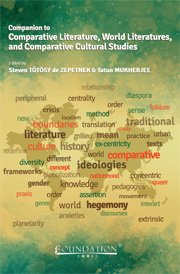Book contents
- Frontmatter
- Contents
- Introduction to the Companion to Comparative Literature, World Literatures, and Comparative Cultural Studies
- PART 1 Theories of Comparative Literature, World Literatures, and Comparative Cultural Studies
- PART 2 Comparative Literature in World Languages
- PART 3 Examples of New Work in Comparative Literature, World Literatures, and Comparative Cultural Studies
- African Literatures and Cultures and the Universal of Motherhood
- World literatures and the Case of Joyce, Rao, and Borges
- Abject Spaces and the Hinterland in Bolaño's Work
- The Motif of Fleeing in Gao's Work
- Arab Fiction and Migration in the Work of Haqqi and Salih
- Sexual Identity and Translation in Prime-Stevenson's Work
- The Notion of Life in the Work of Agamben
- Aesthetics, Opera, and Alterity in Herzog's Work
- An Intermedial Reading of Paley's Sita Sings the Blues
- Painting and Representation in Teaching Balzac
- PART 4 Multilingual Bibliography of Books in Comparative Literature, World Literatures, and Comparative Cultural Studies
- Index
Painting and Representation in Teaching Balzac
from PART 3 - Examples of New Work in Comparative Literature, World Literatures, and Comparative Cultural Studies
Published online by Cambridge University Press: 05 April 2014
- Frontmatter
- Contents
- Introduction to the Companion to Comparative Literature, World Literatures, and Comparative Cultural Studies
- PART 1 Theories of Comparative Literature, World Literatures, and Comparative Cultural Studies
- PART 2 Comparative Literature in World Languages
- PART 3 Examples of New Work in Comparative Literature, World Literatures, and Comparative Cultural Studies
- African Literatures and Cultures and the Universal of Motherhood
- World literatures and the Case of Joyce, Rao, and Borges
- Abject Spaces and the Hinterland in Bolaño's Work
- The Motif of Fleeing in Gao's Work
- Arab Fiction and Migration in the Work of Haqqi and Salih
- Sexual Identity and Translation in Prime-Stevenson's Work
- The Notion of Life in the Work of Agamben
- Aesthetics, Opera, and Alterity in Herzog's Work
- An Intermedial Reading of Paley's Sita Sings the Blues
- Painting and Representation in Teaching Balzac
- PART 4 Multilingual Bibliography of Books in Comparative Literature, World Literatures, and Comparative Cultural Studies
- Index
Summary
Abstract: In her article “Painting and Representation in Teaching Balzac” Janet Moser explores the relation of text and image for use in pedagogy. The roots of Balzac's realist representational program in seventeenth-century Dutch genre painting have been noted frequently and studied extensively. However, description and narrative are in many respects oppositional and the Balzac/Dutch analogy can be taken only so far. Balzac believed that he had grafted ethically meaningful dramatic action onto a morally static model of Dutch descriptive realism. In class discussions and exercises — through the analysis of Balzac's rhetoric and a survey of Dutch painting — students explore the connections between Balzac's understanding of representation in Dutch painting and his representation of the culture of Restoration Paris.
Introduction
The classic nineteenth-century European novel in translation sits at the hub of a network of fundamental interdisciplinary connections within the teaching institutions of the English-speaking world. Playing the role of the “immediate Other” opposite the study of the contemporary English novel, continental fictions have served both to link the rhetorical tactics generically, representational strategies of the English novel to cognate literary concerns, and to provide students with a broader, less Anglo-centric view of how the novel came to represent concerns arising in the industrializing worlds of the nineteenth century. A byproduct of the generalization achieved by dislodging the novel from its traditional embedding in language-based studies is an emerging, institutionally-important role for studies of “realism” and the nineteenth-century novel as models for critical inquiry into issues of representation in visual, material, and social worlds.
- Type
- Chapter
- Information
- Companion to Comparative Literature, World Literatures, and Comparative Cultural Studies , pp. 484 - 496Publisher: Foundation BooksPrint publication year: 2014

